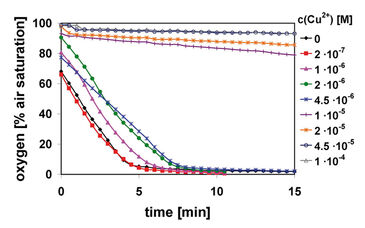Watch tutorials, webinars and informative videos about PreSens optical sensor systems.
Non-Invasive Online Oxygen Measurement
Bacterial toxicity tests for use in pharmacological agent
Anna Vasilevskaya
Institute for Analytical Chemistry, University of Regensburg, Germany
Measurement of oxygen kinetics in respiration inhibition tests is of central importance for pharmacological agent research and toxicology testing of chemicals (REACH). The new SDR SensorDish® Reader makes non-invasive, simultaneous, online recording in 24-well plates possible for the first time ever. The study describes the use of the system in a bacterial-respiratory toxicity test.
New Rapid Test with 24-Well Format
The Pseudomonas putida (P. putida) oxygen consumption inhibition test (1) is used to investigate the effect of a test substance on cellular respiration in bacteria using oxygen electrodes. Conventional oxygen electrodes, however, are unsuitable for high sample throughputs because effective miniaturization - the prerequisite for simultaneous use in small-volume samples - is only possible to a limited extent and invasive measurement can lead to contamination. This test has been adapted for the 24-well format of the SensorDish® Reader. The SensorDish® Reader reads out the oxygen content in a noncontact manner by means of optical sensors on the bottom of the 24-well plate (OxoDish®). With the corresponding software, up to 10 instruments, with a total of 240 samples, can be monitored simultaneously.
Sample Preparation
P. putida Migula (DSM 50026) was grown on the standard agar S1 for 24 h, and an overnight culture (16 h) of this was grown in an S1 medium. The bacteria were washed with a phosphate buffer (pH: 7.2, 50 mM) and adjusted to an optical density (OD436) of 0.4 dilution. A copper sulfate solution with eight concentrations ranging from 1x10-4 M to 2x10-7 M was used as the test substance. Deviations from the standard procedure were the use of a higher bacterial concentration and the addition of 100 mM of NaCl to the test solution. A mixture of 0.4 mL of the bacterial solution, 0.4 mL of a 2.5 M glucose solution, and 19.2 mL of the copper sulfate solution was preincubated at 23°C for 30 minutes in a shake flask with agitation. From this mixture, 3 mL/well were transferred to the OxoDish® and the oxygen content of the sample detected for 15 minutes with no agitation using the SensorDish® Reader.
Recording of DO Kinetics
The kinetics (Fig. 2) showed that low copper sulfate concentrations (up to 10-6 M) had no inhibiting effect on oxidative metabolism. The oxygen consumption of the culture decreased with increasing copper sulfate concentration; at copper sulfate concentrations of 4.5x10-5 M and higher, bacterial respiration was completely inhibited. Comparison of kinetics for uninhibited bacterial respiration and that of bacteria treated with the test substance in different concentrations allows the degree of inhibition to be calculated by means of the slope.
The inhibition is derived from the quotient of known measurement values: 100 x (slope without inhibition - slope with inhibition) / slope without inhibition. From the resultant dose-response curve (Fig. 3), an EC50 value of 5.0 x 10-6 M (1.25 mg/L) of copper sulfate was obtained. The EC50 (half-maximal effective concentration) is defined as the test substance concentration that leads to an oxygen consumption inhibition level of 50 % in the test organism.
Simultaneous Screening of Multiple Samples
The results correspond closely with the information known about the toxicity of copper sulfate and confirm the results of a previous study (2). They thus serve to demonstrate the great potential of the new measurement technology for use in pharmacological / toxicological screening tests. The SensorDish® Reader enables rapid, simultaneous measurement of a large number of samples. Because the sample remains stationary during the measurement, the passive oxygen input over the short measurement duration of 15 minutes is negligible, making it unnecessary to cover the sample. Culture medium, bacterial quantity, and test substance requirements are low in comparison with those of the conventional method (test volume reduced from 100 mL to 3 mL), as is the time needed for testing, since the system is easy to use and requires no calibration. Cost-intensive and delicate oxygen electrodes can be done away with. The SDR SensorDish® Reader offers an economical and fast test method for use in active agent research and toxicology.
References
1. Pseudomonas putida Atmungshemmtest (Pseudomonas putida Respiration Inhibition Test), DIN 38412, Part L27:1992.
2. Deutsche Einheitsverfahren zur Wasser-, Abwasser- und Schlamm-Untersuchung (German Standard Procedure for Water, Wastewater, and Sediment Testing), Part VI, Wiley-VCH, Weinheim (2001)





